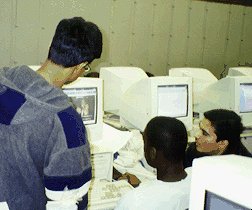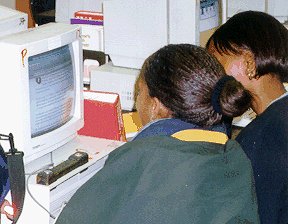|
We learn by doing
Ted remembers: After finishing my ninth grade, I was ready for a summer vacation. My folks had other plans. My dad set up an interview with some guy at a local construction company, because my dad wanted me to begin to learn a craft, something on which to fall if all else failed. Smart man, my dad. I didn't think so at the time, but that skill came in very handy in the early 80's when I needed a job. I worked as a carpenter for a while to make ends meet. Anyway, that ninth grade summer loomed to be a disaster. I got the job and began banging nails that summer instead of hanging out at the beach watching the babes and surfing. I had an epiphany very early in that job. I was working on a roof, helping in the cutting and putting together the rafters. My boss, Ed Strojny, was showing me how easy it was to figure out the right cut and to determine the angle using simple geometry. I had spent half a year in a geometry class, learned nothing, hated it, and was bored silly by all the stupid triangles and drawings my teacher prided himself on drawing free hand. Well, on that very hot summer afternoon, I learned geometry. Not only did I learn a craft which kept me fed when I was 30, but I also learned geometry. I learned it by doing it - in an AUTHENTIC environment - and because it was relevant. I couldn't wait to get back to school to explain to my teacher how useful geometry was to me that summer. The teacher wasn't impressed when I told him the story. He was one of the reasons I became a teacher: to to every thing the opposite of what my old geometry teacher would have done. I remember the carpenter's name but not my teacher's name. This certainly supports what Dewey once said, "We learn by doing after we have reflected on what we have done." Lori remembers: In 1972, my family took a trip to Williamsburg, Virginia. The carpenter, I learned, had an apprentice. I thought that made sense. How else, after all, would somebody learn how to do something?
What was deemed Progressivism in Dewey's time has become Constructivism under the guidance of Seymour Papert at MIT. Papert promotes the idea of child power especially in this digital age and provides practical methods to help the child become more of a part in hir learning while the teacher becomes more of a guide. In keeping with this thinking, "passionate teachers convey their passion to novice learners - their students - by acting as partners in learning, rather than as "experts in the field." (Fried, p23) If we accept the idea that we do learn by doing, then we have to find ways to let the learner do rather than sit and receive from the teacher. Papert suggests the technology is an ideal way to make practical the theories on learning by doing Dewey and Piaget. But the real proof is how the scholar students react and actually do it this environment. At this point, we'd like to direct you to what Ted's student's have been saying about this class, about this type of learning, and introduce their SCHOLARSHIP. Below are links to student's webfolio piece which sums up their year, provides some assessment, links to all of their work, and a general idea for the reader what the learner experienced as heard straight from the learner's mouth. Dewey outlines much of this in his Democracy and Education. Not only does he addresss the importance of our DIVERSE cultures in this democracy, but Dewey also lays down a foundation upon which the technology is about animating the theory, practice it by doing it. Imagine that, using the theory to define the practice: practical theory. Dewey to define Dewey. Dewey is quick to remind us of our origins: Learning by doing is the way most folks ultimately learn anything and everything. If knowledge is POWER, then we gain that knowledge by doing. Here's what we do. First of all we use an acceptable use policy (AUP) with every online student and a parent permission slip to establish tone and to make a contract between all parties. Secondly obtain web access through school or any of the free web sites and email sites. We highly recommend that each student maintain a permanent web address not associated with the school for hir own webfolio. We encourage the students to have a web identity of their own and one they can maintain and keep after leaving the school. Thirdly, the teacher may need to consider morphing into a Cybrarian.
In Ted's class, he has his students working in a UNIX environment. This is not available to all. However, the same principle he employs can be used for most teachers and is available by using a basic editor like Notepad or Wordpad and having the students write the code manually in this program and saving it as an HTML file before viewing it in any browser. Ted starts his classes the first day of the year by having the students code their homepage and to set up their paper template file which they use for each web essay. Through collaboration, play, and experimenting the students become very adroit in HTML coding. The philosophy is that by learning the simple codes, a student will be able to trade up to any WYSIWYG environment like Netscape Composer, Frontpage, PageMill or even the free web sites. The major disadvantage to starting with an HTML editor might be in the tweaking later on. The HTML editors are cumbersome. Lori uses the free web sites for her students to create their webfolios. Since she only has Internet access and no webspace or email provided by the school she has to use the available free resources on the web for her students. This may be the case for many teachers, and actually has certain advantages. By having the students use the free websites, we teach them responsibility, take liability away from the school, and avoid situations of censorship by the school of a particular student. The Internet provides a natural place for us to put theory into practice. We wouldn't expect to teach a person to ride a bicycle by having hir listen to a lecture on bicycle riding. Our students are learning about literacy-- reading, writing, inquiry, decision making, and more-- everyday, by doing.
© TedNellen & Lori Mayo 2000 |
 earning by doing has been a mantra for educators through the ages. It was recited in the Homeric epics and spoken in the Shakespearean plays, read in Montaigne's essays and enjoyed in Twain's stories. The story of learning is always about doing. The story of learning is a tale of bridging the gap between theory and practice, the cadence to which educators march. We have a couple of stories to relate which we think illustrate our interpretation of learning by doing.
earning by doing has been a mantra for educators through the ages. It was recited in the Homeric epics and spoken in the Shakespearean plays, read in Montaigne's essays and enjoyed in Twain's stories. The story of learning is always about doing. The story of learning is a tale of bridging the gap between theory and practice, the cadence to which educators march. We have a couple of stories to relate which we think illustrate our interpretation of learning by doing.

